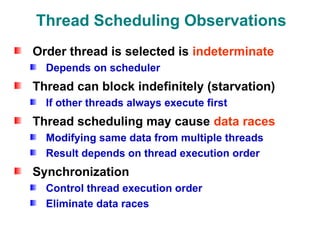Ad
Advanced Java Programming for Beginners.
- 1. Multithreading in Java Fawzi Emad Chau-Wen Tseng Department of Computer Science University of Maryland, College Park
- 2. Problem Multiple tasks for computer Draw & display images on screen Check keyboard & mouse input Send & receive data on network Read & write files to disk Perform useful computation (editor, browser, game) How does computer do everything at once? Multitasking Multiprocessing
- 3. Multitasking (Time-Sharing) Approach Computer does some work on a task Computer then quickly switch to next task Tasks managed by operating system (scheduler) Computer seems to work on tasks concurrently Can improve performance by reducing waiting
- 4. Multitasking Can Aid Performance Single task Two tasks
- 5. Multiprocessing (Multithreading) Approach Multiple processing units (multiprocessor) Computer works on several tasks in parallel Performance can be improved 4096 processor Cray X1 32 processor Pentium Xeon Dual-core AMD Athlon X2
- 6. Perform Multiple Tasks Using… 1. Process Definition – executable program loaded in memory Has own address space Variables & data structures (in memory) Each process may execute a different program Communicate via operating system, files, network May contain multiple threads
- 7. Perform Multiple Tasks Using… 2. Thread Definition – sequentially executed stream of instructions Shares address space with other threads Has own execution context Program counter, call stack (local variables) Communicate via shared access to data Multiple threads in process execute same program Also known as “lightweight process”
- 8. Motivation for Multithreading 1. Captures logical structure of problem May have concurrent interacting components Can handle each component using separate thread Simplifies programming for problem Example Web Server uses threads to handle … Multiple simultaneous web browser requests
- 9. Motivation for Multithreading 2. Better utilize hardware resources When a thread is delayed, compute other threads Given extra hardware, compute threads in parallel Reduce overall execution time Example Multiple simultaneous web browser requests… Handled faster by multiple web servers
- 10. Multithreading Overview Motivation & background Threads Creating Java threads Thread states Scheduling Synchronization Data races Locks Wait / Notify
- 11. Programming with Threads Concurrent programming Writing programs divided into independent tasks Tasks may be executed in parallel on multiprocessors Multithreading Executing program with multiple threads in parallel Special form of multiprocessing
- 12. Creating Threads in Java Two approaches Thread class public class Thread extends Object { … } Runnable interface public interface Runnable { public void run(); // work thread }
- 13. Thread Class public class Thread extends Object implements Runnable { public Thread(); public Thread(String name); // Thread name public Thread(Runnable R); // Thread R.run() public Thread(Runnable R, String name); public void run(); // if no R, work for thread public void start();// begin thread execution ... }
- 14. More Thread Class Methods public class Thread extends Object { … public static Thread currentThread() public String getName() public void interrupt() public boolean isAlive() public void join() public void setDaemon() public void setName() public void setPriority() public static void sleep() public static void yield() }
- 15. Creating Threads in Java 1. Thread class Extend Thread class and override the run method Example public class MyT extends Thread { public void run() { … // work for thread } } MyT T = new MyT () ; // create thread T.start(); // begin running thread … // thread executing in parallel
- 16. Creating Threads in Java 2. Runnable interface Create object implementing Runnable interface Pass it to Thread object via Thread constructor Example public class MyT implements Runnable { public void run() { … // work for thread } } Thread T = new Thread(new MyT); // create thread T.start(); // begin running thread … // thread executing in parallel
- 17. Creating Threads in Java Note Thread starts executing only if start() is called Runnable is interface So it can be multiply inherited Required for multithreading in applets
- 18. Threads – Thread States Java thread can be in one of these states New – thread allocated & waiting for start() Runnable – thread can begin execution Running – thread currently executing Blocked – thread waiting for event (I/O, etc.) Dead – thread finished Transitions between states caused by Invoking methods in class Thread new(), start(), yield(), sleep(), wait(), notify()… Other (external) events Scheduler, I/O, returning from run()…
- 19. Threads – Thread States State diagram runnable scheduler new dead running blocked new start terminate IO, sleep, wait, join yield, time slice notify, notifyAll, IO complete, sleep expired, join complete
- 20. Daemon Threads Java threads types User Daemon Provide general services Typically never terminate Call setDaemon() before start() Program termination 1. All user threads finish 2. Daemon threads are terminated by JVM 3. Main program finishes
- 21. Threads – Scheduling Scheduler Determines which runnable threads to run Can be based on thread priority Part of OS or Java Virtual Machine (JVM) Scheduling policy Nonpreemptive (cooperative) scheduling Preemptive scheduling
- 22. Threads – Non-preemptive Scheduling Threads continue execution until Thread terminates Executes instruction causing wait (e.g., IO) Thread volunteering to stop (invoking yield or sleep)
- 23. Threads – Preemptive Scheduling Threads continue execution until Same reasons as non-preemptive scheduling Preempted by scheduler
- 24. Java Thread Example public class ThreadExample extends Thread { public void run() { for (int i = 0; i < 3; i++) System.out.println(i); try { sleep((int)(Math.random() * 5000)); // 5 secs } catch (InterruptedException e) { } } public static void main(String[] args) { new ThreadExample().start(); new ThreadExample().start(); System.out.println("Done"); } }
- 25. Java Thread Example – Output Possible outputs 0,1,2,0,1,2,Done // thread 1, thread 2, main() 0,1,2,Done,0,1,2 // thread 1, main(), thread 2 Done,0,1,2,0,1,2 // main(), thread 1, thread 2 0,0,1,1,2,Done,2 // main() & threads interleaved thread 1: println 0, println 1, println 2 main (): thread 1, thread 2, println Done thread 2: println 0, println 1, println 2
- 26. Data Races public class DataRace extends Thread { static int x; public void run() { for (int i = 0; i < 100000; i++) { x = x + 1; x = x – 1; } } public static void main(String[] args) { x = 0; for (int i = 0; i < 100000; i++) new DataRace().start(); System.out.println(x);// x not always 0! } }
- 27. Thread Scheduling Observations Order thread is selected is indeterminate Depends on scheduler Thread can block indefinitely (starvation) If other threads always execute first Thread scheduling may cause data races Modifying same data from multiple threads Result depends on thread execution order Synchronization Control thread execution order Eliminate data races





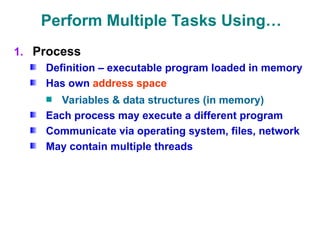









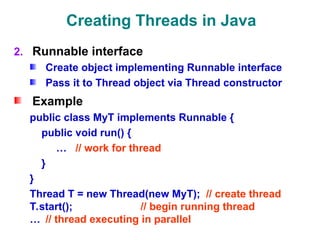
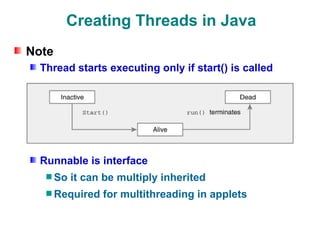




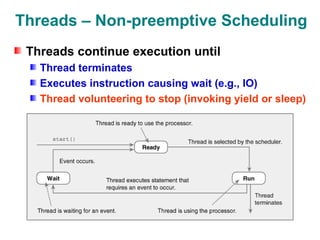

![Java Thread Example
public class ThreadExample extends Thread {
public void run() {
for (int i = 0; i < 3; i++)
System.out.println(i);
try {
sleep((int)(Math.random() * 5000)); // 5 secs
} catch (InterruptedException e) { }
}
public static void main(String[] args) {
new ThreadExample().start();
new ThreadExample().start();
System.out.println("Done");
}
}](https://image.slidesharecdn.com/lec30-241109153116-d0da06ca/85/Advanced-Java-Programming-for-Beginners-24-320.jpg)

![Data Races
public class DataRace extends Thread {
static int x;
public void run() {
for (int i = 0; i < 100000; i++) {
x = x + 1;
x = x – 1;
}
}
public static void main(String[] args) {
x = 0;
for (int i = 0; i < 100000; i++)
new DataRace().start();
System.out.println(x);// x not always 0!
}
}](https://image.slidesharecdn.com/lec30-241109153116-d0da06ca/85/Advanced-Java-Programming-for-Beginners-26-320.jpg)
